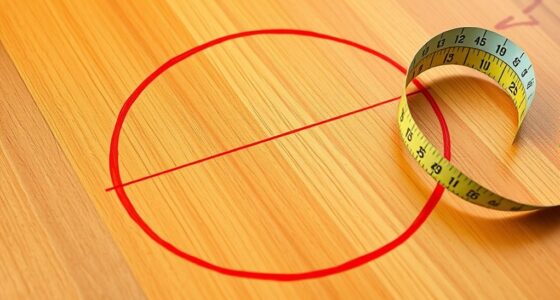When exploring polygons, you’ll notice that convex shapes have all their interior angles less than 180°, with vertices pointing outward and no dents in the shape. In contrast, concave polygons have at least one interior angle greater than 180°, creating inward dents or indentations. Recognizing these differences helps you quickly classify shapes and understand their properties, which is useful in various fields. Keep exploring to learn more about how these shapes behave and are used.
Key Takeaways
- Convex polygons have all interior angles less than 180°, with vertices pointing outward.
- Concave polygons contain at least one interior angle greater than 180°, creating inward dents.
- The shape’s shape and vertex angles determine if a polygon is convex or concave.
- Convex polygons bulge outward uniformly, while concave polygons have inward indentations.
- Analyzing vertex angles helps distinguish between convex and concave polygon shapes.

Have you ever wondered what makes a shape a polygon? It all comes down to the way the shape is classified and the properties of its vertices. A polygon is a closed, two-dimensional shape made up of straight line segments called sides. To understand what separates one polygon from another, you need to look at polygon classification, which groups polygons based on their properties. One of the most important aspects of this classification involves examining the vertices, or the points where sides meet. These vertex properties help determine whether a polygon is convex or concave and influence how we analyze the shape’s structure.
When you analyze a polygon’s vertices, you focus on the angles at each point where two sides meet. Each vertex has an interior angle, which is the angle inside the shape at that point. The classification of a polygon often hinges on the nature of these angles. In convex polygons, all interior angles are less than 180 degrees, and each vertex “points outward.” This means that if you draw a line through any vertex, the interior of the shape remains on one side of that line. The convex shape’s vertices have a property where the interior angles are all acute or right angles, and the shape bulges outward uniformly. Because of this, convex polygons are generally easier to work with and analyze.
In contrast, concave polygons have at least one interior angle greater than 180 degrees. At these vertices, the shape “caves in,” creating an inward dent or indentation. The vertex properties of concave polygons are more complex because the shape does not point outward uniformly. Instead, some vertices have angles that are reflex, meaning they are greater than 180 degrees, which affects the way the shape behaves. This inward indentation can be visualized as a “notch” or “dent” on the polygon, and it’s a key feature that distinguishes concave shapes from convex ones. Additionally, the angle measures at each vertex play a critical role in classifying the shape as either convex or concave.
Understanding vertex properties helps you classify and analyze polygons more efficiently. By examining the angles at each vertex, you can quickly determine if a shape is convex or concave. This classification is essential in fields like geometry, computer graphics, and architecture, where the properties of polygons influence design and calculations. Recognizing the role of vertex properties in polygon classification allows you to better understand the shape’s structure and behavior, making it easier to work with various geometric shapes in practical applications.
Frequently Asked Questions
How Do You Determine if a Shape Is Convex or Concave?
To determine if a shape is convex or concave, start with angle measurement at each vertex. If all interior angles are less than 180 degrees, it’s convex. If you find any angle greater than 180 degrees, the shape is concave. Also, perform vertex analysis by drawing a line between two points inside the shape; if the line stays inside, it’s convex. If it crosses outside, it’s concave.
Can a Polygon Be Both Convex and Concave?
Like a shape-shifter in a story, a polygon can’t be both convex and concave at once; it’s classified as one or the other based on its shape properties. Polygon classification relies on angles and side arrangements, and a single polygon cannot possess the traits of both. Understanding this helps you recognize that each shape’s properties define its category, emphasizing the importance of clear distinctions in geometric classification.
What Are the Real-World Applications of Convex Polygons?
Convex polygons have many real-world applications, especially in architectural design where they create stable, aesthetically pleasing structures. In robotics navigation, their shape simplifies calculations for movement and obstacle avoidance. You’ll find convex polygons used in computer graphics, game design, and engineering because their properties make modeling and analysis easier. Their ability to efficiently represent shapes and facilitate calculations makes them essential in various fields that require precision and stability.
How Does the Interior Angle Sum Differ Between Convex and Concave Polygons?
You’ll notice that the interior angles’ sum differs between convex and concave polygons. In convex polygons, the total angle sum follows the formula (n-2)×180°, where n is the number of sides. For concave polygons, the angle sum remains the same, but some interior angles are greater than 180°, making the shape appear ‘caved in.’ So, while the angle sum rule stays consistent, the angles themselves vary depending on the shape’s concavity.
Are There Polygons With More Than 20 Sides That Are Both Convex and Concave?
No, polygons with more than 20 sides can’t be both convex and concave at the same time. Polygon classification depends on shape properties, and a polygon is either convex or concave, not both. Variations in side length ratios affect the shape but don’t change its classification. If a polygon has all interior angles less than 180°, it’s convex; otherwise, it’s concave. So, a polygon can’t be both simultaneously.
Conclusion
Now that you’ve explored convex and concave polygons, you see how each shape has its own unique features. Recognizing their differences helps you understand geometry better and see how shapes work in the real world. Remember, knowing your polygons is like having the key to a treasure chest—once you understand the basics, everything else falls into place. Keep practicing, and soon you’ll spot these shapes everywhere, proving that what’s simple on the surface often has more to it than meets the eye.









